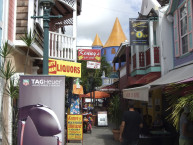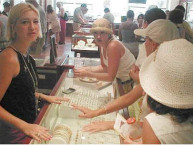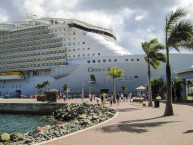Amber
![]()
The Caribbean is home to one of the world’s finest sources of amber, the Dominican Republic.  Amber is the solidified sap of ancient trees which is used to create beads and cabochon cut gems for use in necklaces,
Amber is the solidified sap of ancient trees which is used to create beads and cabochon cut gems for use in necklaces, earrings, and rings. Amber should be worn with an amount of care as it is easily scratched and will react quickly if exposed to any type of harsh liquid or acid.
earrings, and rings. Amber should be worn with an amount of care as it is easily scratched and will react quickly if exposed to any type of harsh liquid or acid.
As shown in the photograph at right, amber often contains the remains of ancient insects which were trapped when the sap dropped onto the branch of the tree. Some amber will also contain leaves and stems from the tree or surrounding plants.
Amber containing insects and finely preserved leaves is very rare and will be quite expensive.


On the left is an amber specimen containing trapped insects. (Dominican Amber) On the right is a drawing of the insects as they appear under magnification.
How can I check if its real Amber?
Amber will float in a saturated salt solution (ten level teaspoonfuls of salt in a large glass of water of water). Plastic will not. However this only works with loose stones . If you are checking a set piece there is the “hot point.” method. Basically its getting a pin head extremely hot and touching it to an area of the Amber. If it emits a pine resin smell it is genuine amber. If it emits a petroleum distillate smell, it may be plastic. Obviously if you walk into a fine jeweler and start attacking the amber jewelry with hot pokers your not going to be real popular. This is where dealing with reputable jewelers is essential. bubbles, plant debris, clouds, inner layers, cracks and fissures, insect parts, opacities, swirls and stresslines are present to some degree in most pieces and can help verify authenticity.
Beware, for example, of a necklace of perfectly matched, transparent beads — that would be most unlikely. Insect inclusions that appear flawless or perfectly placed are also suspect, since most insects and animals entombed in amber show signs of struggle and attempts to flee before dying. They do not march in a neat little line into the amber. They generally had the sap roll over them or they flew into it. They struggle and things fall off, or they appear scrunched up.
The faking of inclusions of amber has been a major cottage industry for generations. This perhaps reached its height in the early 1900 and a major source was from New Zealand. The North Island has some major deposits of Kaori Gum, and at the turn of the 19 century some was used to fake and imitate true amber. The digging of Kaori Gum was such a major industry in fact the workers even had their own newspaper; ‘The Gum Diggers Gazette’.
In general, true ambers give the impression of lightness and warmth and a complex, glowing luster. Many, but by no means all, synthetics feel heavy and cold, and appear to radiate a dull luster.
Amber in History
Amber is the fossilized resin of long extinct pine trees that flourished from forty to sixty million years ago. Amber has fascinated humans for centuries, an ancient name for amber, lyncurius or “lynx stone” arose from the belief that amber was made from solidified lynx urine.
The Chinese believed that Amber was made from the souls of tigers, entering the earth when the animals died. American Indians found Amber stones floating in the lakes and felt these were bits of the sun fallen to Earth. Another name for Amber was electrum, from which we derive “electricity”, because Amber provided the earliest demonstrations of static electricity.
In Norse tradition, it was claimed that the tears of the Goddess Freya became Gold when they fell upon the Earth and lumps of Amber when they fell into the sea. Many myths associated amber with the sun and with immortality from the suns perpetual rebirths.
Romans considered amber nodules so protective that they hung them on nets that defended the podium against wild beasts in the amphitheater. Roman gladiators hung amber on their weapons and armor. Pliny said that a small figurine of amber was thought more valuable than a healthy slave.
The promotion of amber as a cure all is why most of the ancient rosary beads thru-out the centuries have been amber. It is asserted that ambers “high vibratory rate” can purify and clean the entire human body, by emitting a powerful “magnetic flow” that is said to balance the endocrine and digestive systems. Moreover, this magnetic flow can stabilize the heart, the spleen and the base of the spine. It is said that all internal organs can be “revitalized” simply by placing a piece of amber on the skin above.
The largest single piece of amber was unearthed in Sarawak in 1991. It weighs over 150 pounds and is in the collection of the Museum f�r Naturkunde in Stuttgart, Germany.
The Amber Room:
One of the most magnificent uses of a gem material in a building interior was the legendary “Amber Room.” This extraordinary work of art was created early in the eighteenth century for King Frederick William I of Prussia.
The room was first displayed in 1713 in the Royal Palace at Berlin. It was spectacular. Back then royalty designed their homes and palaces to make a statement, be it how powerful, wealthy or how well educated they were. The Amber room made a clear statement.  Done in baroque style, it featured wall panels of various sizes in different shades of Amber, inlaid with intricate carvings. Doors and windows were framed in Amber, and ornate showcases were filled with small, precious amber objects. Here and there, shiny plaques of red amber glowed in contrast to the mass of yellows and browns.
Done in baroque style, it featured wall panels of various sizes in different shades of Amber, inlaid with intricate carvings. Doors and windows were framed in Amber, and ornate showcases were filled with small, precious amber objects. Here and there, shiny plaques of red amber glowed in contrast to the mass of yellows and browns.
Czar Peter the Great of Russia saw the room and was so impressed, Frederick gave it to him as a gift. The Czar had it dismantled, carefully packed, then hauled by sleigh to his Winter Palace at St. Petersburg. In 1755, Peter’s daughter had the rooms panels transferred to the summer palace outside of St. Petersburg. As late as 1763, craftsmen were still making luxurious additions to the prodigious creation, which stayed in Russia into the twentieth century.
The Amber Room – often described as the “Eighth Wonder of the World” – is currently valued at about $250,000,000.00.
It consisted of 100,000 pieces of carved amber paneling covering 55 square meters. The amber, which covered three walls, was arranged in three tiers.
The central (middle) tier consisted of eight large, symmetrical vertical panels. Four of them contained pictures made of precious stones executed in the 1750’s in Florence, using the Florentine mosaic technique. These were designed according by the artist Giuseppe Dzokki, and depicted the five senses: Sight, Taste, Sound, Touch and Smell.
Mirrored pilasters occupied the distance between the large panels. The lower tier of the room was covered in square amber panels. The southwestern corner contained a small amber table on an elegantly turned leg.
The room’s furnishings consisted of inlaid wood commodes of Russian origin, and a vase of Chinese porcelain. In addition, one of the most valuable collections of amber objects created in the 17th and 18th centuries by German, Polish and Petersburg masters was housed in the room’s glass-covered display cases
Abrupt temperature changes and stove heating damaged the amber. During the 19th century, the room was restored three times: in 1833, 1865, and between 1893 and 1897. During the 1920s and 1930s I. V. Krestovsky performed minor repairs. Major restoration was scheduled for 1941.
During the first days of World War II, when the evacuation of the treasures from the Catherine Palace was already underway, it was decided, due to the fragility of the Amber Room, not to send it further behind the lines. Instead, it was decided to preserve the room on the spot, without taking down the walls. Paper was first glued over the walls, then they were covered in gauze and cotton.
The German troops invading the town of Pushkin (Tzarskoje Selo) brought with them specialists from the Kunstkommission. The occupants dismantled the panels and sent them to Koenigsberg. Number 200 of the Koenigsberg Gift Record notes that the room was bequeathed to the museum by the German State Directorate for Palaces and Parks.
The stolen amber panels and doors were displayed in one of the halls on the third floor of the Koenigsberg Palace. The museum’s director, Alfred Rode, wrote in 1944 that the Amber Room, now returned to its homeland, was the best exhibit in the Koenigsberg Museum. This was the last place where the Amber Room was shown.
In 1944, when the Germans retreated, the amber was again dismantled, packed into crates and taken in an unknown direction. Since then the room has been lost. Search efforts have so far been unsuccessful.
After the war, the German official in charge of the amber shipment said the crates were in a castle that burned down in an air raid. A Soviet investigator found a charred fragment from the room. Others think the palace sank to the bottom of the Baltic Sea in a torpedoed steamer or was stashed in an abandoned mine in Thuringia.
Serious historians of the subject have little hope that the room will ever be found. Nonetheless, the Internet bubbles with Amber Room-related theories. A German film company even made an Indiana Jones-style movie based on the story.
Reality caught up with the fantasies in 1997, when a group of German art detectives, including a former Stasi agent, heard talk that someone was trying to hawk a piece of the Amber Room. Police raided the office of a lawyer in Bremen who was trying to sell the work for a client–the son of a German officer who had accompanied the wartime convoy to K�nigsberg. The son said he had no idea how his father got the mosaic.
One theory is that the crates of amber were bombed on the road and the father swiped a chunk of the room as a war trophy, figuring no one would be the wiser. In April, officials from Berlin presented the recovered mosaic to Russian President Vladimir Putin–along with an intricately inlaid chest from the Amber Room that had also turned up–in a goodwill ceremony faintly and oddly reminiscent of that first kingly gift just under 300 years ago.



